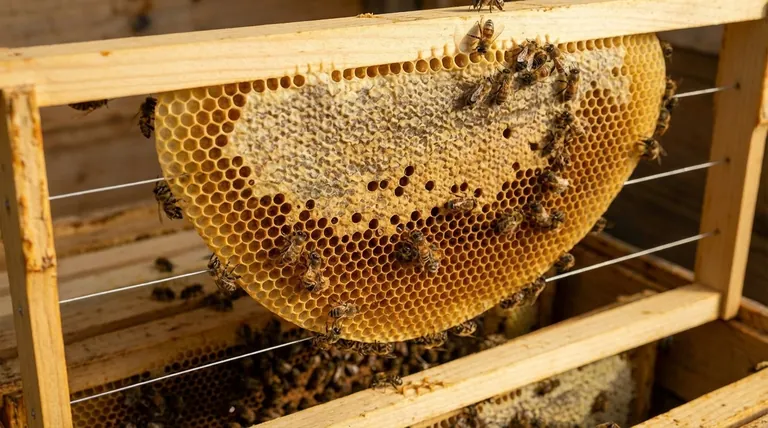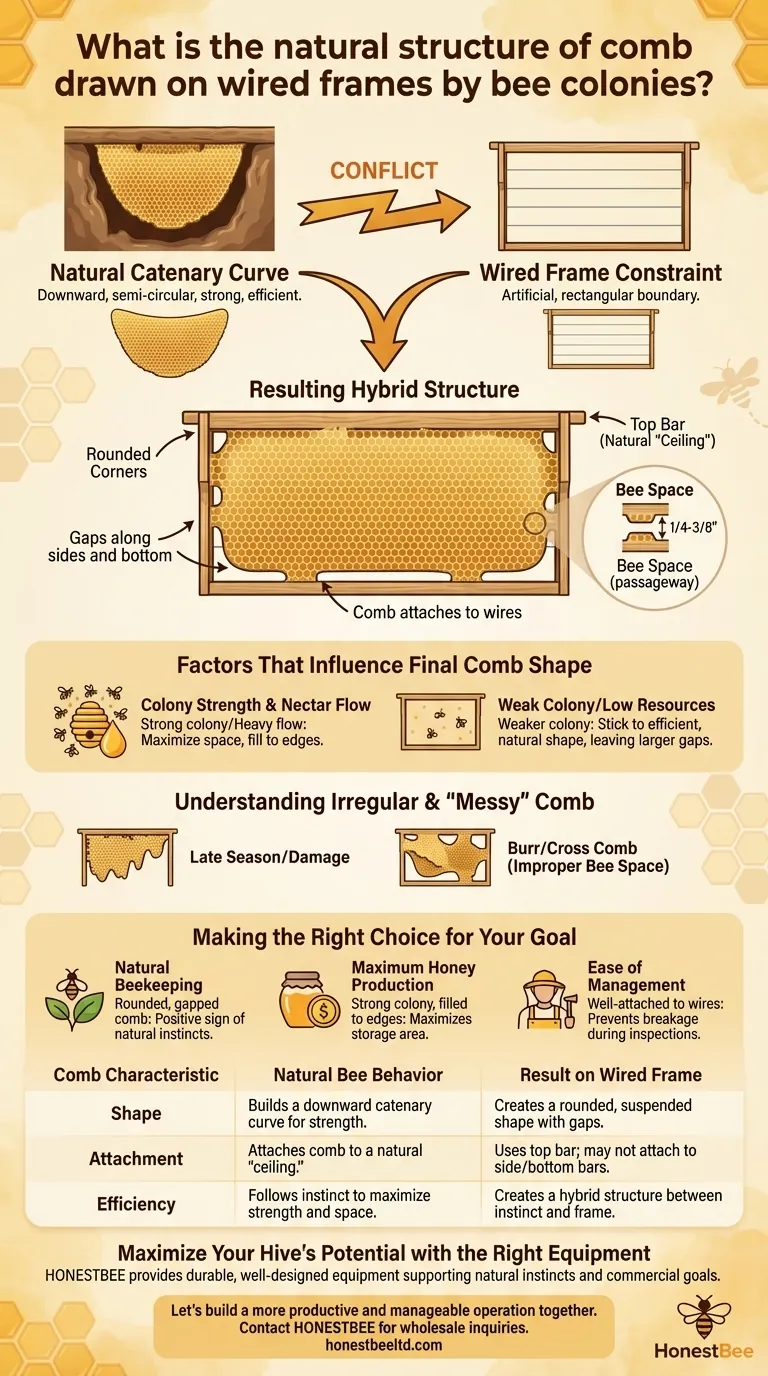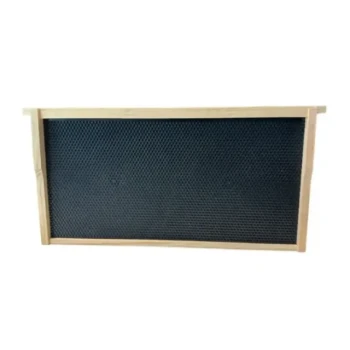In a hive with wired frames, bees will often revert to their natural building instincts. Instead of filling the rectangular frame perfectly, they tend to draw comb in a rounded, suspended shape that frequently leaves gaps along the sides and bottom, mirroring the structure of comb found in the wild.
The core issue is a conflict between the bee's innate tendency to build in a downward, semi-circular "catenary" shape and the rigid, rectangular geometry of the beekeeper's frame. The resulting comb is a functional compromise between these two forces.

The Instinct Behind the Shape: Wild vs. Managed Comb
The Natural Catenary Curve
In nature, bees build comb by hanging it from the ceiling of a cavity. This comb naturally forms a catenary curve—the same shape a heavy chain makes when hung from two points.
This structure is incredibly strong and efficient, allowing the comb to support its own weight plus the significant weight of honey, pollen, and brood.
The Frame's Rectangular Constraint
A beekeeper's frame imposes an artificial, rectangular boundary on the bees. The top bar mimics the ceiling of a natural cavity, but the vertical side bars and horizontal bottom bar are foreign concepts.
The wires running through the frame act as a scaffold, providing support and guidance. However, they do not force the bees to build in a specific way like a full sheet of foundation does.
The Resulting Hybrid Structure
The most common result is a hybrid shape. The bees begin building from the top bar, following their natural downward curve.
They will incorporate the wires into the comb for stability, but they often stop short of attaching the comb firmly to the side and bottom bars, leaving characteristic gaps and rounded corners.
Factors That Influence Final Comb Shape
Colony Strength and Nectar Flow
A very strong, populous colony experiencing a heavy nectar flow is more likely to maximize all available space. In these conditions, they may draw the comb out more completely, filling the frame nearly to the edges.
Weaker colonies or those with fewer resources are more likely to stick to the most efficient, natural shape, leaving larger gaps.
The Importance of "Bee Space"
Bees instinctively maintain a specific gap—known as bee space (roughly 1/4 to 3/8 of an inch)—around their combs to use as a passageway.
If the distance from the edge of their naturally-drawn comb to the frame's side or bottom bar is larger than bee space, they will often leave it empty. If it's smaller, they will fill it with propolis.
Understanding Irregular and "Messy" Comb
Why Irregularities Happen
Not all comb on wired frames follows a neat pattern. "Messy" comb can occur for several reasons.
A colony that is started late in the season may not have the time or resources to finish drawing the comb, leaving it incomplete. Likewise, comb can be damaged during storage or hive inspections.
Burr Comb and Cross Comb
If frames are not spaced correctly, bees may build burr comb to bridge the gap or cross comb that connects multiple frames together. This is a direct result of bees trying to enforce their preferred "bee space" in an improperly configured hive.
This makes hive inspections difficult and can damage the comb, brood, and even the queen when frames are pulled apart.
Making the Right Choice for Your Goal
Understanding this behavior allows you to manage your hives more effectively. The structure of the comb on your wired frames is a direct reflection of your colony's instincts and strength.
- If your primary focus is natural beekeeping: The rounded, gapped comb is a positive sign that your bees are expressing their innate building patterns.
- If your primary focus is maximum honey production: A strong colony that fills the frame to the edges is ideal, as this maximizes the available storage area.
- If your primary focus is ease of management: Ensure the comb is well-attached to the wires to prevent it from breaking during inspections, even if it doesn't meet the frame edges.
Working with the bees' natural tendencies, rather than against them, is the foundation of successful beekeeping.
Summary Table:
| Comb Characteristic | Natural Bee Behavior | Result on Wired Frame |
|---|---|---|
| Shape | Builds a downward catenary curve for strength. | Creates a rounded, suspended shape with gaps. |
| Attachment | Attaches comb to a natural "ceiling." | Uses top bar; may not attach to side/bottom bars. |
| Efficiency | Follows instinct to maximize strength and space. | Creates a hybrid structure between instinct and frame. |
Maximize Your Hive's Potential with the Right Equipment
Understanding bee behavior is the first step; equipping your apiary with the right supplies is the next. Whether you manage a few hives or supply a network of distributors, HONESTBEE provides the durable, well-designed beekeeping equipment that supports both natural bee instincts and your commercial goals.
Let’s build a more productive and manageable operation together.
Contact HONESTBEE today for wholesale inquiries to explore our full range of wired frames, foundations, and hive components tailored for commercial apiaries and distributors.
Visual Guide

Related Products
- HONESTBEE Wired and Assembled Wooden Bee Frames Foundation for a Thriving Hive
- Plastic Bee Frame Beekeeping Hive Frames for Wholesale
- Heart-Shaped Comb Honey Frame and Honeycomb Cassette
- Assembled Wooden Bee Frames with Beeswax Foundation Ready to Use by HONESTBEE
- Plastic Honey Comb Frames Cassette Box for Honey
People Also Ask
- Can I reuse old frames? A practical guide to saving money and reducing waste
- How should you dry bee frames after cleaning? Prevent Warping and Ensure Hive Health
- Can old bee frames be reused? Weighing the Risks vs. Rewards for Your Hive
- When should I throw away my bee frame? A Guide to Hive Health & Frame Rotation
- What should I look for in a bee frame? A Beekeeper's Guide to Hive Health Assessment



















